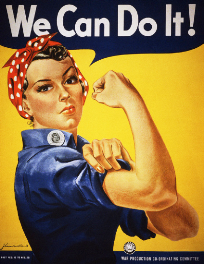 In March we celebrate Women’s History Month. In recent years, many engaging books about women have been published, especially in the new genre of picture book biographies and in nonfiction narratives about the role of women in history. Authors have taken a deeper look at many behind the scene scenarios where women actually played a pivotal role in making or changing history.
In March we celebrate Women’s History Month. In recent years, many engaging books about women have been published, especially in the new genre of picture book biographies and in nonfiction narratives about the role of women in history. Authors have taken a deeper look at many behind the scene scenarios where women actually played a pivotal role in making or changing history.
The Children’s Literature and Reading SIG presents an array of fiction and nonfiction books that will be of interest to students and teachers all year long and provide young readers excellent choices to see girls and women featured prominently in the stories. For classroom ideas, visit ReadWriteThink.org’s calendar event, “March is National Women's History Month.”
Grades K-2
Fern, Tracey E. (2014). Dare the Wind. Illus. by Emily Arnold McCully. New York: Margaret Ferguson Books/ Farrar Straus Giroux/Macmillan.
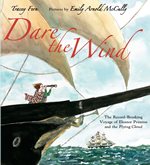 A new addition to the picture book biography genre, this is the story of Ellen Prentiss Creesy, the daughter of a Marblehead, Massachusetts schooner captain, who lived from 1814 to 1900. Growing up surrounded by the sea and developing her own love of sailing and navigation through her father’s lessons, she married a man who loved the sea as much as she did.
A new addition to the picture book biography genre, this is the story of Ellen Prentiss Creesy, the daughter of a Marblehead, Massachusetts schooner captain, who lived from 1814 to 1900. Growing up surrounded by the sea and developing her own love of sailing and navigation through her father’s lessons, she married a man who loved the sea as much as she did.
This story features a special 1851 voyage of her husband’s clipper ship, the Flying Cloud, as Ellen navigated their journey down the east coast, around Cape Horn and on to the Gold Rush regions of California carrying passengers and cargo. Their voyage was the fastest journey to date as the fever for gold impacted fortune seekers. Emily Arnold McCully’s watercolor illustrations are the perfect complement to frame the hazards of the voyage including roaring storms and the rolling motion of the ship—and clear skies as well. At a time when women were hardly allowed aboard a ship, let alone being the owner and navigator of the vessel, Ellen set the world record for making that “round the Horn” trip in the least time.
–Karen Hildebrand, Ohio Library and Reading Consultant
Polacco, Patricia. (2014). Clara and Davie: The True Story of Young Clara Barton, Founder of the Red Cross. New York: Scholastic Press.
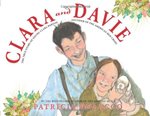 Patricia Polacco has written another family story from the annals of her own ancestry. Her story begins on Christmas, 1821, the night that Clarissa, later known as Clara, was born. Her mother was ill for a very long time following her birth so her older sister Dolly became her chief caretaker and her older brother Davie became her confidant and protector. Young Clara developed an unusual affinity for plants and animals and even in her young life, her healing hands became well known. However, Clara spoke with a pronounced lisp and school children made fun of her to the point she did not want to go to school. Her family banded together to teacher her math and reading at home.
Patricia Polacco has written another family story from the annals of her own ancestry. Her story begins on Christmas, 1821, the night that Clarissa, later known as Clara, was born. Her mother was ill for a very long time following her birth so her older sister Dolly became her chief caretaker and her older brother Davie became her confidant and protector. Young Clara developed an unusual affinity for plants and animals and even in her young life, her healing hands became well known. However, Clara spoke with a pronounced lisp and school children made fun of her to the point she did not want to go to school. Her family banded together to teacher her math and reading at home.
One day, when Davie fell from the loft of the barn and was critically injured, it was Clara who nursed him back to health after an arduous 3-year long recovery. Davie predicted then that she would “grow up to be a very great lady.” Polacco has included detailed notes at the end about Clara Barton’s contribution to medicine and healing, the creation of the Red Cross, and her own family connection to Clara Barton.
—Karen Hildebrand, Ohio Library and Reading Consultant
Tonatiuh, Duncan. (2014). Separate is Never Equal, Sylvia Mendez and Her Family’s Fight for Desegregation. New York: Abrams Books for Young Readers.
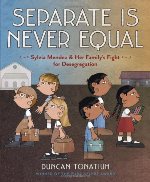 Sylvia Mendez starts school at Westminster and is treated badly by students there. When she gets home from school and tells her mother she doesn’t want to go back, her mother explains the fight they have just been through for the right to attend Westminster. Seven years before Brown v Board of Education there was Mendez v Westminster School District in the state of California.
Sylvia Mendez starts school at Westminster and is treated badly by students there. When she gets home from school and tells her mother she doesn’t want to go back, her mother explains the fight they have just been through for the right to attend Westminster. Seven years before Brown v Board of Education there was Mendez v Westminster School District in the state of California.
When Sylvia Mendez and her brothers moved from crowded Santa Ana, California, to a smaller farming community of Westminster they tried to enroll in the local school. They were refused admittance and told they had to attend the Mexican School. Aunt Soledad questioned why and got no real answer. When Sylvia’s parents got involved in questioning why their children could not go to the local and closest school, they never got an answer. Gonzalo Mendez, Sylvia’s father, travels around the area to get other parents to join his fight for better education in integrated schools for his own children and for everyone.
After a several-year battle that included Thurgood Marshall and then California governor Earl Warren, later chief justice of the U.S. Supreme Court, their case was won and minority children were permitted to attend the local public school. Tonatiuh has not only told an accurate accounting of this case and given a look at the time period, but his detailed author notes, glossary, bibliography, and index add extensive resources for this piece of civil rights history.
—Karen Hildebrand, Ohio Library and Reading Consultant
Grades 3-5
Demi. (2014). Florence Nightingale. New York: Henry Holt and Co.
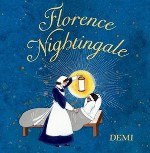 Florence Nightingale (1820-1910) was born into an English family of privilege who lived in Florence, Italy at the time. From an early age, Florence traveled with her parents to different countries in Europe and often home to England, and in later years she often visited hospitals and poorhouses to observe how patients were cared for and what techniques and practices seemed most helpful. After her studies as a nurse, she led a group of nurses to Turkey to assist with medical needs during the Crimean War. She was convinced that cleanliness, better hygiene, and patient care that included hot nutritious food was the best way to get soldiers back to good or improved health.
Florence Nightingale (1820-1910) was born into an English family of privilege who lived in Florence, Italy at the time. From an early age, Florence traveled with her parents to different countries in Europe and often home to England, and in later years she often visited hospitals and poorhouses to observe how patients were cared for and what techniques and practices seemed most helpful. After her studies as a nurse, she led a group of nurses to Turkey to assist with medical needs during the Crimean War. She was convinced that cleanliness, better hygiene, and patient care that included hot nutritious food was the best way to get soldiers back to good or improved health.
Demi’s detailed illustrations depict all the things nurses were doing to care for their patients—cleaning and scrubbing, changing linens, and attending to medicines and patient care. Nightingale’s contributions to the medical field are lauded in this beautifully executed picture book biography.
—Karen Hildebrand, Ohio Library and Reading Consultant
Hunter, Nick. (2014). Women in World War I. Chicago: Heinemann Library.
 The world was at war and men were leaving the country to fight on foreign soil. American women had to step up and fill in as needed. Illustrated with archival photographs, fact boxes, journal entries, quotations, and bold print vocabulary words, this book covers many aspects of the first world war and the roles women played. Chapter headings include: How did World War I change women’s lives; What was life like for women before the war; What did women do on the home front; How did women care for the wounded; Did women fight in the war; What challenges did women face at home; What happened to women at the end of World War I; Remembering the Women of World War I; Timeline and Glossary.
The world was at war and men were leaving the country to fight on foreign soil. American women had to step up and fill in as needed. Illustrated with archival photographs, fact boxes, journal entries, quotations, and bold print vocabulary words, this book covers many aspects of the first world war and the roles women played. Chapter headings include: How did World War I change women’s lives; What was life like for women before the war; What did women do on the home front; How did women care for the wounded; Did women fight in the war; What challenges did women face at home; What happened to women at the end of World War I; Remembering the Women of World War I; Timeline and Glossary.
Each page is full of information that offers an introduction with brief information about this war.
–Karen Hildebrand, Ohio Library and Reading Consultant
Kimmelman, Leslie. (2014). Hot Dog! Eleanor Roosevelt Throws a Picnic. Illus. by Victor Juhasz. Ann Arbor, MI: Sleeping Bear Press.
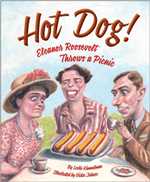 A little known moment of American history is brought to light in this delightful story and it centers on hot dogs. Eleanor Roosevelt, First Lady to her husband President Franklin Delano Roosevelt was quite a woman. President Roosevelt was a victim of polio and spent most of his adult life, including his presidential years, in a wheelchair. Eleanor became his legs and voice as she traveled the country to let people know that the President was listening to their concerns and needs.
A little known moment of American history is brought to light in this delightful story and it centers on hot dogs. Eleanor Roosevelt, First Lady to her husband President Franklin Delano Roosevelt was quite a woman. President Roosevelt was a victim of polio and spent most of his adult life, including his presidential years, in a wheelchair. Eleanor became his legs and voice as she traveled the country to let people know that the President was listening to their concerns and needs.
In 1939, an invitation was extended to England’s King George VI and his wife Queen Elizabeth. No English monarch had been on American soil since the war for independence from England. As part of their visit, Eleanor wanted to invite the royal couple for a country getaway and made preparation for a picnic at the Roosevelt country home in Hyde Park on the Hudson River. This beautiful country setting was the perfect spot for a picnic that included Eleanor’s favorite—hot dogs! As the nation learned what the First Lady intended to serve the visiting royalty, she received hundreds of letters stating that hot dogs seemed totally inappropriate for visiting heads of state. Eleanor assured concerned citizens that there would be plenty of good food options. The visit was a huge success and in the years during World War II, the Roosevelts and the British Royal Family stayed in contact and remained close friends. Though FDR died before the end of the war and never made the intended trip to visit the King and Queen in England, Eleanor made the trip that she so enjoyed.
On June 11, 1989, fifty years after the first picnic, Hyde Park hosted another hot dog picnic and many of the people attending had been children at the first picnic. Queen Elizabeth sent a message recalling the first picnic and how much she and the king had enjoyed the day and appreciated the friendship that spanned an ocean and a war.
—Karen Hildebrand, Ohio Library and Reading Consultant
Powell, Patricia Hruby. (2014). Josephine: The Dazzling Life of Josephine Baker. Illus. by Christian Robinson. San Francisco: Chronicle Books.
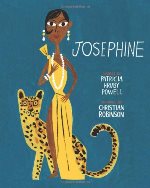 Written in jazzy, exuberant verse, this picture book unfolds around the life of Josephine Baker. Born in St. Louis (1906) in an era of racial segregation and outrage, Josephine’s talented dance routines brought her attention and led her to the stage by the age of 13. Leaving home to follow the her dream, she continues to confront racial prejudices—though she is allowed to dance on stage, she is not allowed to walk in the front door. As her talent continues to be recognized, she eventually goes to France where she is welcomed and the racial divide is not so troubling. Her flamboyant and courageous life includes a pet leopard with diamond collar and work as a spy for the French during the war years. Actual quotes from Josephine Baker are sprinkled into the verse of this rhythmic biography.
Written in jazzy, exuberant verse, this picture book unfolds around the life of Josephine Baker. Born in St. Louis (1906) in an era of racial segregation and outrage, Josephine’s talented dance routines brought her attention and led her to the stage by the age of 13. Leaving home to follow the her dream, she continues to confront racial prejudices—though she is allowed to dance on stage, she is not allowed to walk in the front door. As her talent continues to be recognized, she eventually goes to France where she is welcomed and the racial divide is not so troubling. Her flamboyant and courageous life includes a pet leopard with diamond collar and work as a spy for the French during the war years. Actual quotes from Josephine Baker are sprinkled into the verse of this rhythmic biography.
—Karen Hildebrand, Ohio Library and Reading Consultant
Roberts, Cokie. (2014). Founding Mothers; Remembering the Ladies. Illus. by Diane Goode. New York: HarperCollins.
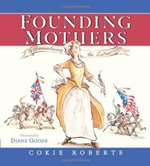 Based on her adult book, “Founding Mothers; The Women Who Raised Our Nation” (2004), award-winning journalist Cokie Roberts brings ten ladies of the revolution to a younger reading audience. Roberts has used journals, diaries, personal letters, ledgers, and lists to deliver factually researched information about the lives of the women who served behind the scenes during the American Revolution.
Based on her adult book, “Founding Mothers; The Women Who Raised Our Nation” (2004), award-winning journalist Cokie Roberts brings ten ladies of the revolution to a younger reading audience. Roberts has used journals, diaries, personal letters, ledgers, and lists to deliver factually researched information about the lives of the women who served behind the scenes during the American Revolution.
The patriotic women include Abigail Adams, Mercy Otis Warren, Deborah Reed Franklin, Eliza Lucas Pinkney, Catharine Littlefield Greene, Esther DeBerdt Reed, Martha Washington and Dolly Madison. Each two-page spread features Diane Goode’s ink and watercolor illustrations that depict the period in every detail. Listen to Cokie Roberts discuss this book at this NPR interview or watch this 4 minute ABC News video interview.
—Karen Hildebrand, Ohio Library and Reading Consultant
Woods, Brenda. (2014). The Blossoming Universe of Violet Diamond. New York: Nancy Paulsen Books/Penguin Group.
 Biracial 11-year-old Violet feels like a misfit in her family living in a small town suburb in Washington. Her mother is white and her father, who died in a car accident before she was born, is black. People automatically assume she is adopted, as she “looks like a brown leaf on a pile of white snow.” Violet begins to research her father’s family and learns that her estranged grandmother, a celebrated artist and her father’s mother, is coming to Seattle and so Violet makes plans to meet her. At first, her grandmother wants nothing to do with Violet, but her persistence and need for touching her roots from this side of her heritage wins over her grandmother. In her search for identity and fitting into society as biracial, Violet learns the meaning of family.
Biracial 11-year-old Violet feels like a misfit in her family living in a small town suburb in Washington. Her mother is white and her father, who died in a car accident before she was born, is black. People automatically assume she is adopted, as she “looks like a brown leaf on a pile of white snow.” Violet begins to research her father’s family and learns that her estranged grandmother, a celebrated artist and her father’s mother, is coming to Seattle and so Violet makes plans to meet her. At first, her grandmother wants nothing to do with Violet, but her persistence and need for touching her roots from this side of her heritage wins over her grandmother. In her search for identity and fitting into society as biracial, Violet learns the meaning of family.
—Karen Hildebrand, Ohio Library and Reading Consultant
Grades 6-8
Nardo, Don. (2014). The Split History of the Women's Suffrage Movement, Suffragists' Perspective; The Split History of the Women's Suffrage Movement, Anti-Suffragists' Perspective. North Mankato, MN: Capstone Books.
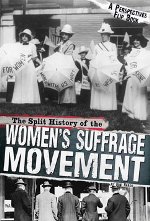 From the publisher’s “Perspectives Flip Book” series, this back-to-back, inverted flip book presents two sides to the women’s suffrage movement during the mid-1800s and into the twentieth century. Using archival photographs, drawings and renderings, primary documents, and newspaper accounts, the women’s right to vote movement is presented. Teachers who are looking for ways to present points of view will find this book useful as one side represents the suffrage movement and the activists working toward that goal while the flipped side of the book presents the opposition.
From the publisher’s “Perspectives Flip Book” series, this back-to-back, inverted flip book presents two sides to the women’s suffrage movement during the mid-1800s and into the twentieth century. Using archival photographs, drawings and renderings, primary documents, and newspaper accounts, the women’s right to vote movement is presented. Teachers who are looking for ways to present points of view will find this book useful as one side represents the suffrage movement and the activists working toward that goal while the flipped side of the book presents the opposition.
Details from the 1848 Seneca Falls Convention were put forth as women drafted and signed documents declaring it was time for women to be allowed to participate in legal decisions through their vote. Elizabeth Cady Stanton shared her document, “The Declaration of Sentiments and Resolutions” patterned after the Declaration of Independence. Lucretia Mott, Susan B. Anthony, Charlotte Woodward, Paula Wright-Davis and other contributing women are mentioned in these pages.
—Karen Hildebrand, Ohio Library and Reading Consultant
Phillips, Jennifer. (2014). Girls Research! Amazing Tales of Female Scientists. North Mankao, MN: Capstone Press.
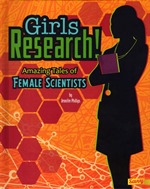 The fascinating women included in this book were true pioneers and broke down barriers to blaze trails where women had not yet gone. To quote the opening page, “They had to fight to go school … They had to fight for jobs … They had to fight for respect … They developed thick skin and pursued science with curiosity, courage and determination. Medical cures, discoveries about ancient civilizations, new species, revelations about the size of the universe … the list of accomplishments marches on. What a different world this would be if female scientists hadn’t persevered.”
The fascinating women included in this book were true pioneers and broke down barriers to blaze trails where women had not yet gone. To quote the opening page, “They had to fight to go school … They had to fight for jobs … They had to fight for respect … They developed thick skin and pursued science with curiosity, courage and determination. Medical cures, discoveries about ancient civilizations, new species, revelations about the size of the universe … the list of accomplishments marches on. What a different world this would be if female scientists hadn’t persevered.”
A few of the women scientists included are: Shirley Ann Jackson, physics; Anna Freud, psychiatry; Edna Foa, psychiatry; Marie Curie, physics; Gertrude Elion and Jane Cooke Wright, chemotherapy; Susan Solomon, atmospheric chemistry; Sylvia Earle, oceanography; Chien-Shiung Wu, atom smashing; Temple Grandin, animal science; Elena Aprile, astrophysics; Francoise Barre-Sinoussi, virology; Joycelyn Elders, public health; Ingrid Daubechies, physics/mathematics; Frances Glessner Lee, forensic science; and Rosaling Franklin, DNA science. A timeline and index conclude the book.
—Karen Hildebrand, Ohio Library and Reading Consultant
Grades 9-12
Earl, Esther. (2014). This Star Won't Go Out: The Life and words of Esther Grace Earl. With Lori and Wayne Earl. Introduction by John Green. New York: Dutton Books.
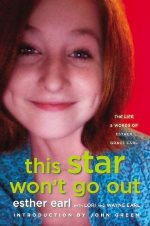 John Green’s popular YA novel, “The Fault in Our Stars,” was dedicated to Esther Grace Earl saying, “Esther Earl, whose life was a gift to me and many.” Esther died in 2010 at the age of 16 from thyroid cancer. This new book is a compilation of her journals, letters, fiction pieces, and sketches of her writing during her illness.
John Green’s popular YA novel, “The Fault in Our Stars,” was dedicated to Esther Grace Earl saying, “Esther Earl, whose life was a gift to me and many.” Esther died in 2010 at the age of 16 from thyroid cancer. This new book is a compilation of her journals, letters, fiction pieces, and sketches of her writing during her illness.
Family and friends have added to the book through writings and photographs. Esther’s poignant pieces put together her thoughts on life—and death. Her outlook and attitude affected all who knew her and may help others coping with life-threatening illness. Teachers might like to use the companion website to this book at http://tswgo.org/ or use this newspaper article from the Boston Globe as a short text to accompany the novel. Teachers might also like to use this video featuring Esther’s mother that explains the TSWGO Foundation concept.
—Karen Hildebrand, Ohio Library and Reading Consultant
Gibson, Karen Bush. (2014). Women in Space: 23 Stories of First Flights, Scientific Mission, and Gravity-Breaking Adventures. Chicago: Chicago Review Press.
 Last year Gibson brought readers, Women Aviators (2013).This year’s book might serve as a companion to that with the 23 stories of astronauts from around the world as they pioneered women’s history in outer space. The book is divided into four parts starting with the Mercury 13 program where 13 women were invited into the astronaut program and often surpassed the men in certain test categories, but were eventually washed out of the program.
Last year Gibson brought readers, Women Aviators (2013).This year’s book might serve as a companion to that with the 23 stories of astronauts from around the world as they pioneered women’s history in outer space. The book is divided into four parts starting with the Mercury 13 program where 13 women were invited into the astronaut program and often surpassed the men in certain test categories, but were eventually washed out of the program.
Part two deals with the Soviet Cosmonaut program in Russia. Part three centers on American female astronauts Sally Ride, Mae Jemmison, and Peggy Whitson who were female firsts in space. The final part of the book details the lives of astronauts from other parts of the globe including Japan, Canada, Italy, France, and South Korea. Sidebars, source notes, glossary, further reading, and bibliography add to the resources found at the end.
—Karen Hildebrand, Ohio Library and Reading Consultant
More Resources
Social Studies and the Young Learner. Jan/Feb. 2014: The entire issue is devoted to “Remember the Ladies.”
Digital Connections
Women’s History Month for Teachers: Library of Congress Resources
The History Channel: Women’s History Month
NEA: Women’s History Month for the Classroom
Edutopia: Women’s History Month
Smithsonian Education: Women’s History Resources
The Amelia Bloomer Project and Book Awards
These reviews are submitted by members of the International Reading Association's Children's Literature and Reading Special Interest Group (CL/R SIG) and are published weekly on Reading Today Online.
The CL/R SIG is accepting submissions to the fall 2014 edition of their journal, The Dragon Lode, through April 15, 2014. There is an open theme, and they invite manuscripts that explore contemporary issues and questions, genre study, literary theory, and research related to children's literature and reading. Manuscripts should be no longer than 20 double-spaced, typed pages. Use APA (6th edition) formatting. Author's name, affiliation, mailing address, telephone and fax numbers, and e-mail address should be on a separate cover page. Photos and illustrations should be sent as a separate jpeg file. Any reference to the author that would enable the reviewer to know the author's identity should not appear in the manuscript. Submit all manuscripts to: Dr. Ruth McKoy Lowery, Co-editor.
CL/R SIG will host a special session entitled Children's Literature: The Perfect Teachable Moment on Saturday, May 10 at 3:00 p.m. at the International Reading Association 59th Annual Conference in New Orleans. The session celebrates award-winning children's and young adult books and authors. Author Nancy Bo Flood is the keynote session speaker. Her work encompasses more than a dozen books. Her recent historical fiction "Warriors in the Crossfire" is set in Saipan during WWII, and was selected on the 2011 Notable Books for a Global Society (NBGS) list. The NBGS list represents selections and authors from all genres K-12, with a focus on understanding of and appreciation for the world's full range of diverse cultures, ethnic, and racial groups. The session will also include presentation of the 2014 Notable Books for a Global Society (NBGS) list by members of the selection committee. Visit http://www.iraconference.org to learn more about IRA 2014 or to register.